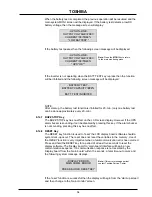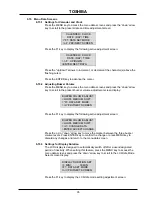
TOSHIBA
20
6.0 Operating the UPS
6.1
Operating the UPS
6.1.1 AC Input Mode (normal operation)
The following illustration shows circuit power flow when the UPS is operating
normally in the AC input mode. The UPS unit's rectifier, including a boost chopper
circuit, converts AC input power to DC power. The boost chopper circuit maintains a
constant voltage, with current limiting, for charging the batteries. It also supplies a DC
voltage of the proper level to the inverter section. The inverter section generates a
high quality sinewave output voltage. The unit's batteries are always maintained in a
constantly charged state when the UPS are in the normal operation mode.
Power flow in AC input mode for the 75 and 100 kVA models
6.1.2 Circuit-bypass Mode
If the UPS unit is severely overloaded or develops an internal fault, power flow is
automatically switched from the unit's main circuit to the units bypass circuit. Power
flow through the bypass is shown in the following illustration. This changeover occurs
automatically in less than 4 milliseconds in phase. The switching period is not long
enough to cause interruptions to occur in most loads. If the power flow is transferred
to the bypass circuit because of an overload, and that overload condition ends within
a specified period of time, then the power flow will be "re-transferred" to the AC input
mode (normal operation) automatically.
If the power flow is transferred to the
bypass circuit due to a fault condition, then the power flow must be transferred
manually from the UPS's bypass circuit back to the inverter circuit after
repairing the fault
(see Section 6.11 "Start-up Procedure").
If the power flow is
transferred to the bypass circuit due to an overload condition, then the power
flow will automatically transfer from the UPS's bypass circuit back to the
inverter circuit after removing the overload
(see Section 6.16 "Overload
Operation").
Power flow in circuit-bypass mode for 75 and 100 kVA models
















































